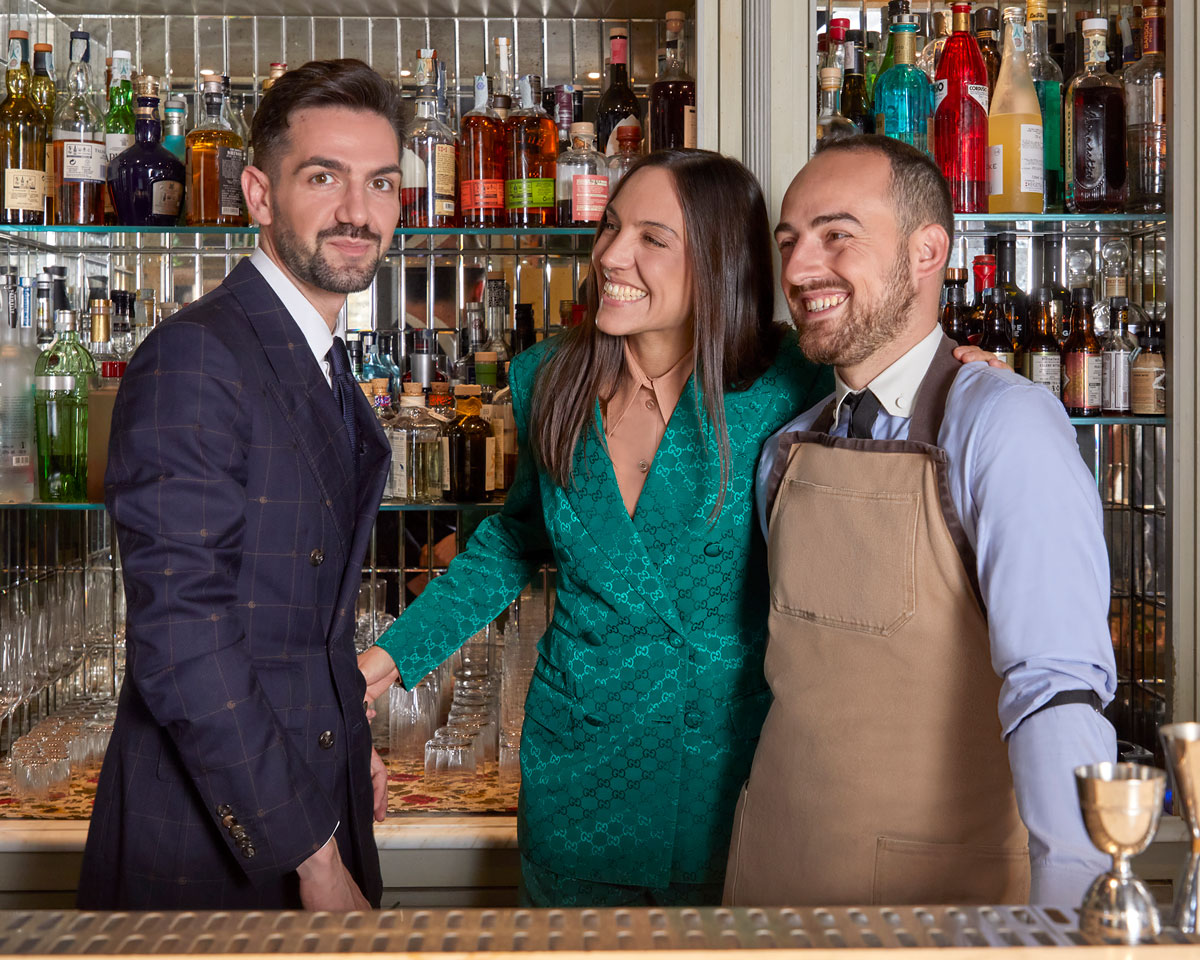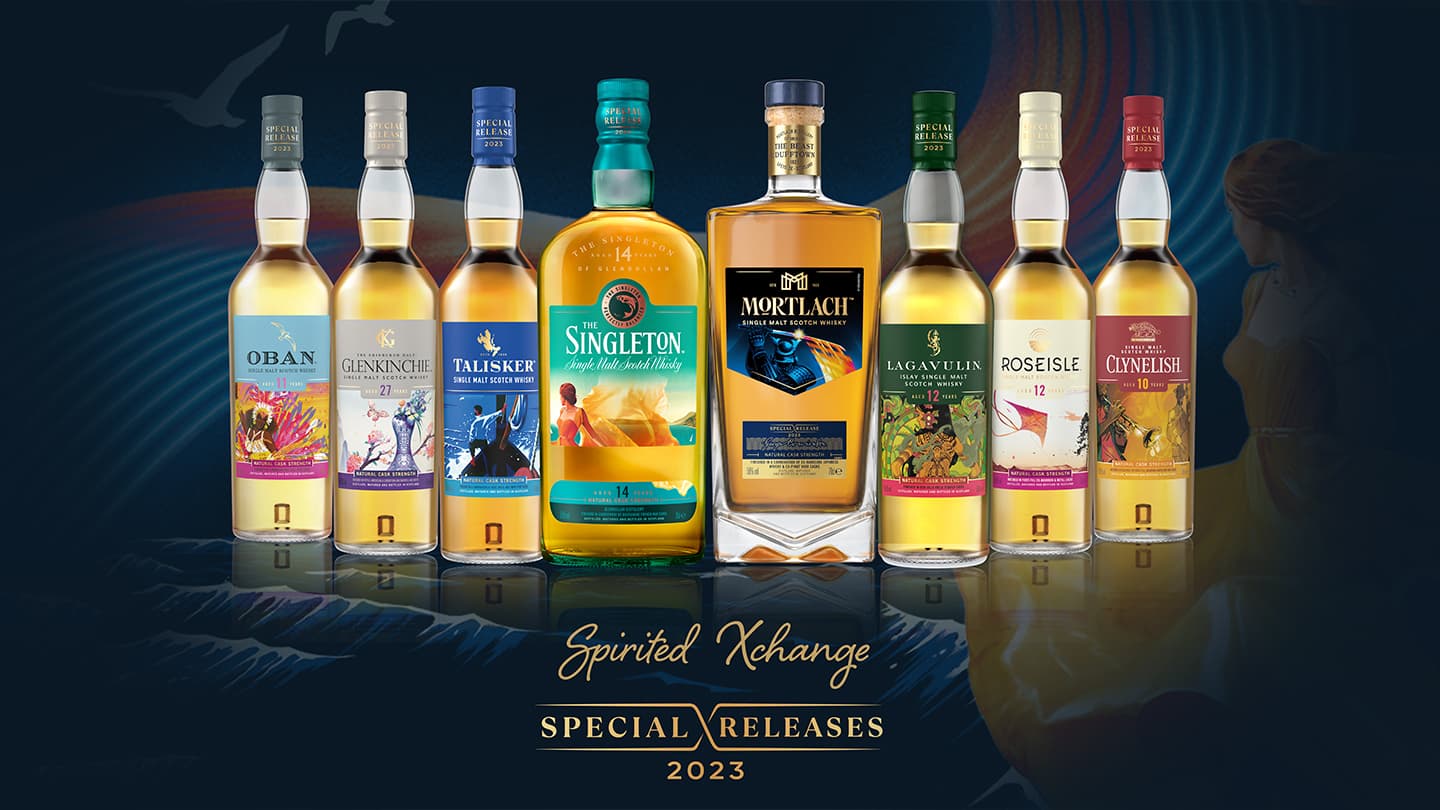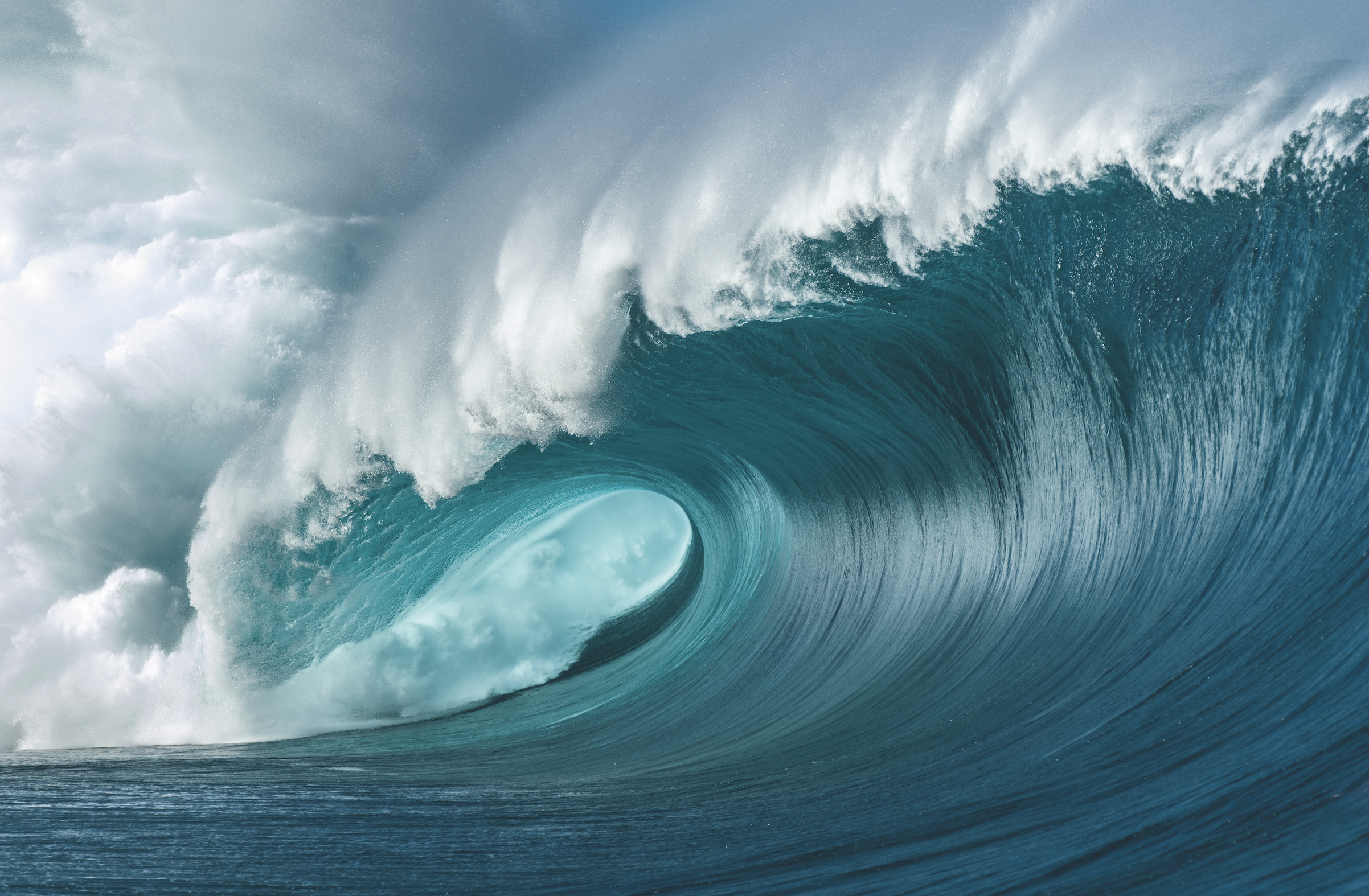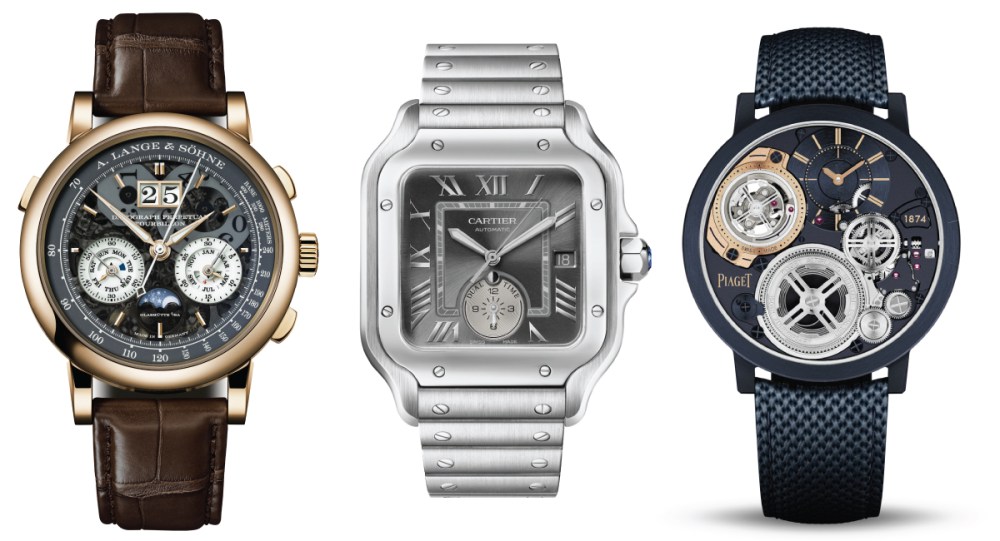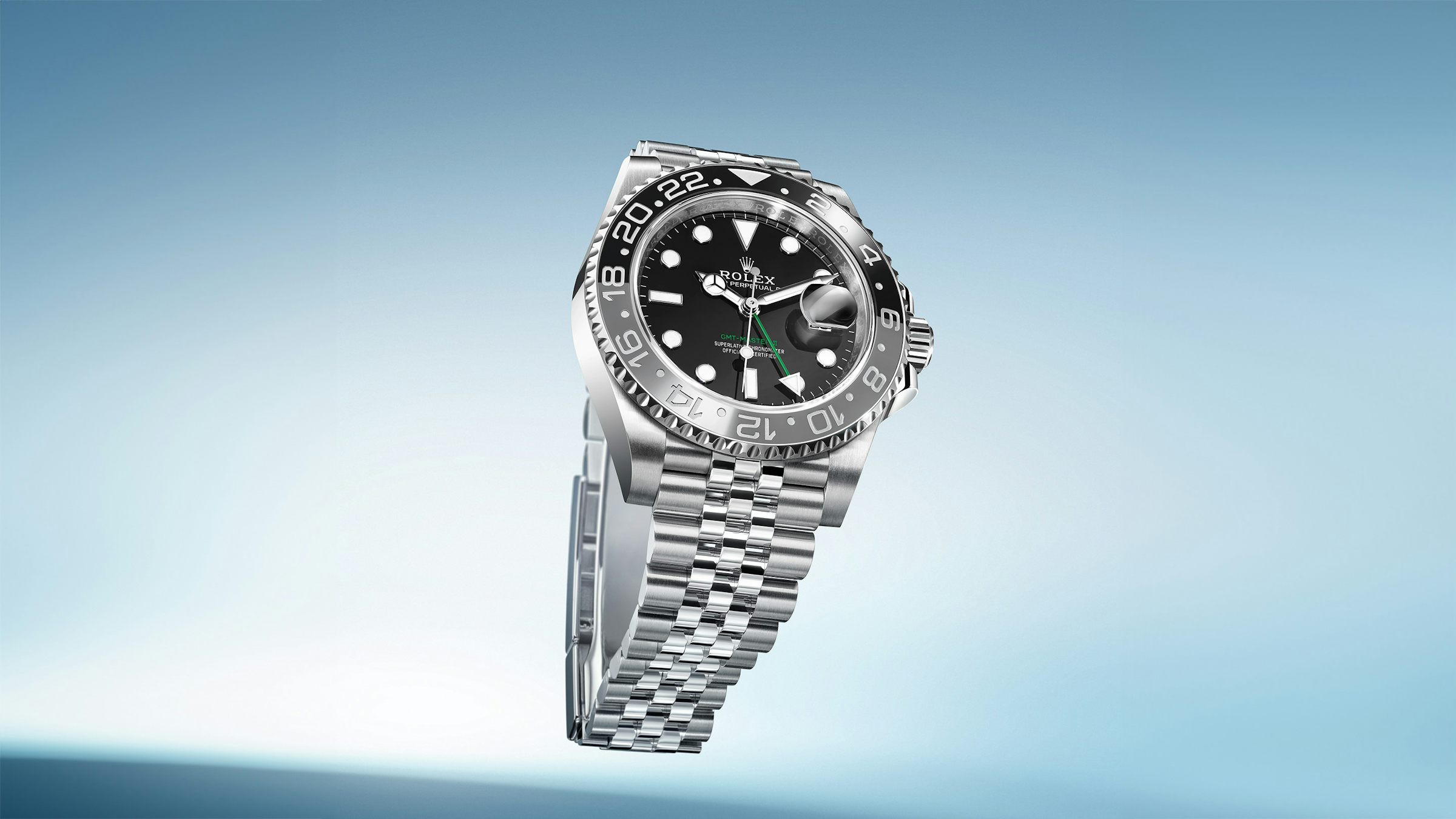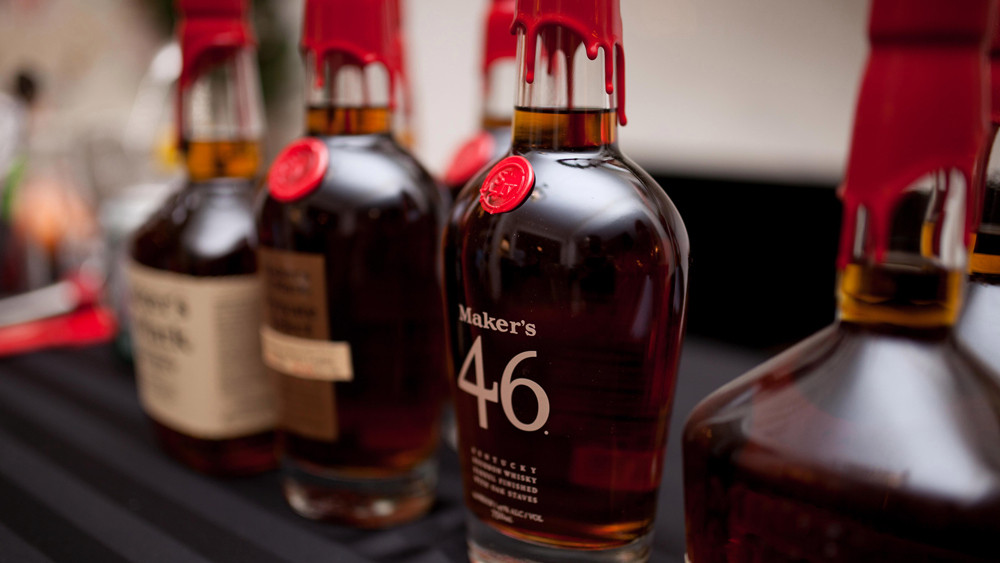
The 15 Best Bourbons of the Past 20 Years
Bourbons have become increasingly collectible. Here are the ones you need to stash away.
Related articles
There’s much to love about the world’s great Japanese, Scottish and Irish whisky-slash-whiskey distilleries. But when it comes to innovation, the wily bourbon producers in the United States have been leading the way for years. In Kentucky and beyond, purveyors of America’s native spirit have refused to let the excellence of their existing products stand in the way of coming up with new ones. And over the last decade and a half, a plenitude of incredible new whiskey with a mash bill of at least 51 per cent corn and aged in charred new oak barrels—the house rules for a whiskey to be called a bourbon—has come to market, some from brand-new producers, others new expressions from venerated houses. Here are 15 of the best bourbon releases of the past 20 years.

Four Roses Small Batch Bourbon
Photo: Courtesy of Four Roses
## Al Young 50th Anniversary Small Batch Bourbon from Four Roses
Released in June 2017 to commemorate Kentucky Distillers’ Association Hall of Famer Al Young’s 50 years of employment at Four Roses, this is as fine a tribute as you can get. A blend of four distinct proprietary recipes, the “Al Young,” as it’s affectionately known US$150 (around $210), exhibits aromas of sweet caramel and floral honeysuckle. The palate offers fresh peach and apricot flavours, encompassing luxurious, warm fig and rich oak, with a hint of mint on the finish. Expect to pay significantly more on the secondary market.

Photo: Courtesy of Barrell Craft Spirits
## Barrell Bourbon Batch 009
Barrell Craft Spirits was founded in 2013 and quickly became one of the most buzzed-about producers of American whiskey. Barrell Bourbon Batch 009 US$90 (around $125) arrived in stores in 2016 and sold out everywhere virtually overnight. Today it can be acquired only on the secondary market. You are hereby advised to get some. Distilled in Tennessee and aged in Kentucky, it’s a 112-proof flavour bomb, offering everything from tropical fruit to thick clotted cream. This bourbon possesses a familiar warmth, like a favorite old blanket or pair of wool socks. The boundless finish is reminiscent of sweet buttered caramel corn.

Photo: Courtesy of Angel’s Envy
## Angel’s Envy Cask Strength Bourbon Finished in Port Barrels
Legendary master distiller Lincoln Henderson released this Angel’s Envy cask-strength expression US$180 (around $255) to great acclaim in 2012. It turned out to be his swan song. Henderson passed away in September 2013, leaving a legacy of artistry and innovation that will not soon be forgotten. The Port Barrel–finished whiskey is a magnificent testament to his abilities. After six years spent resting in new white American oak, the spirit was refined in 60-gallon ruby port barrels made from French oak and imported directly from Portugal. European influence aside, this is still the epitome of complex, bold Kentucky bourbon. The palate teems with flavours, from raisin to banana to rich dark chocolate. A clean and lingering finish offers a hint of Madeira that slowly fades. At 124.5 proof, it packs a serious wallop.

Photo: Courtesy of Russell’s Reserve
## Russell’s Reserve 1998
In 1998, before master distiller Jimmy Russell’s 45th anniversary at Wild Turkey (and assumed retirement), his son Eddie set out to create a fitting tribute to his father’s legacy. Enter Russell’s Reserve 1998 US$250 (around $350). Ole Jimmy can still be found at the distillery today, but his “retirement whiskey” is another story. Just over 2,000 bottles of this 102.2-proof bourbon were released in 2015 and sold out immediately. Of course, when it comes to running down impossible-to-find bottles, there’s always a guy who knows a guy who knows a guy . . . just be aware that that guy will want some serious coin for this collector’s item. As with most bourbon this mature, it’s woody and a tad dry. But Eddie made sure to halt the aging process in time to retain the vibrant caramel, vanilla and fruity notes for which Wild Turkey is so famous. Of course he did—his dad wouldn’t have it any other way.

Photo: Courtesy of High Wire Distilling Co.
## High Wire New Southern Revival Straight Bourbon made with Jimmy Red Corn
Jimmy Red is a legendary moonshiner’s corn that had all but become extinct until a South Carolina farmer brought it back to life in the early aughts. By 2016 the folks at High Wire Distilling in Charleston, who felt that many of the “big boys” in the industry weren’t paying enough attention to the quality of corn used in the mash, were using Jimmy Red to make truly unique bourbon. The Jimmy Red Corn Straight Bourbon US$99 (around $140) smells of nutmeg and toffee. The first sip is nutty, sweet and mineralic. Swish it around a bit to unbind banana and butterscotch flavours. It boasts an extremely high oil content, yielding whiskey with an unusually creamy mouthfeel.
## High West American Prairie Bourbon
Founded with a single 250-gallon still in Park City in 2006, High West has grown from a tiny operation to an internationally recognized brand for a simple reason: its excellent whiskey. American Prairie US$35 (around $50) is a blend of straight bourbons aged from two to 13 years. Rich and earthy on the palate, it possesses pleasant notes of candy corn, honey nougat and sweet corn bread biscuits, closing out with a flash of Granny Smith apple. Every purchase comes with a karmic boost, as well—High West donates 10 percent of profits from the sale of each bottle to the American Prairie Reserve, which is dedicated to protecting and preserving America’s natural resources.

Photo: Courtesy of Knob Creek
## Knob Creek Limited Edition 2001
Part of the first wave of so-called “small batch” bourbons that now command the market, Knob Creek was introduced in 1992 by the late great Jim Beam master distiller Booker Noe. Booker ran the show at Beam for more than 40 years and did yeoman’s work to help revitalize the flagging bourbon industry in the 1960s and ’70s. In 2001, Booker retired and was replaced by his son Fred. This limited-edition expression, released in 2016, marked that historic passing of the torch. Knob Creek Limited Edition 2001 was offered in five batches, each with robust oak and char notes balanced by sweet vanilla and warm brown spices. The finish is long, rich, and glowing.

Photo: Courtesy of PM Spirits
## Mic.Drop.
Set aside any misgivings you might have about liquor named after a worn-out Internet meme, and just enjoy the delicious blend of 20 different casks of eight-year-old whiskey. This spirit offers multifarious flavours highlighted by maple syrup, coconut, cloves, and dark fruit. Mic.Drop. US$100 (around $140) came out of nowhere in 2017 and now resides on the back bars of some of the country’s most prestigious drinking establishments. It’s easy to spot, too, with an eye-catching label designed by comic book artist Chris Batista. Word is that all 3,358 original bottles are spoken for, but fret not, for Mic.Drop.2 was just released on Sept. 1. Okay, maybe fret a little—there will be but 140 bottles, which will retail for US$450 (around $635) a pop.

Photo: Courtesy of Heaven Hill
## John E. Fitzgerald Very Special Reserve 20 Year Old
Whiskey lovers tend to speak of the old Stitzel-Weller Distillery in hushed, reverential tones. Before being shuttered in 1972, the facility produced brands such as Larceny, Old Fitzgerald, Pappy Van Winkle and Weller’s Cabin Still. John E. Fitzgerald Very Special Reserve 20 Year Old (US$300 for 375 mL or around $425, for 375 mL) contains wheated bourbon gleaned from 12 barrels produced at old Stitzel-Weller that had been designated for use in Old Fitzgerald. The John E. Fitzgerald Very Special Reserve offers a host of tastes that go great together, from cocoa to lemon to banana cream pie. The finish is lengthy and refined. A few years back, Heaven Hill released a miniscule amount of 375 mL bottles. They claim that’s all they had, yet there are whispers—hushed and reverential—that a secret supply still remains.
## Woodford Reserve Master’s Collection 2009 Seasoned Oak Finish
In the early 1800s, Woodford County Distillery owner Oscar Pepper and master distiller James Crow pioneered key bourbon-making processes such as sour mashing, copper pot distillation, and charred oak cask maturation. To be sure, they done good. Woodford Reserve’s Master’s Collection US$129 (around $180) is the belated thanks they get. Were either still around to sample this rich amber-colored delectation, surely they’d revel in the 2009 Seasoned Oak Finish’s robust oakiness and spice, as well as the keen notes of fruit jam, toasted almond and dark chocolate. The homestretch lolls pleasantly, offering sweet butter and a hint of cool lemon custard. Be forewarned—finding a bottle is darn near a mission impossible.

Photo: Courtesy of Jefferson’s Reserve
## Jefferson’s Twin Oak Custom Barrel
Founded in 1997, Jefferson’s is committed to crafting innovative small-batch blends, as evidenced by its slogan “alchemy is everything.” The brand is definitely onto something, and the 2018 release US$80 (around $115) may well be its most ambitious whiskey yet. For six years Jefferson’s worked with the Independent Stave Company to develop a proprietary flash-charred barrel made with grooved staves that allows for maximum exposure to oak at the peak of flavour. The result is a well-balanced, mocha-tinged whiskey that coats the palate with sweet and spicy goodness. It has a medium-length finish with a touch of cedar and tart lemon.

Photo: Courtesy of Heaven Hill
## Parker’s Heritage Collection Cask Strength Kentucky Straight Bourbon Whiskey
This whiskey was created in tribute to Heaven Hill’s longtime master distiller, Parker Beam. Beam himself personally selected the barrels that were used for the Heritage Collection Cask Strength’s first edition, released in 2007. Beam, who passed away in January 2017, endeavored to make classic Kentucky bourbon. There’s no better example of stellar old-school hooch than this. It’s full-bodied, brimming with dried fruit flavour (figs and raisins) and possessing ample oak and tannins. Originally priced at US$80 (around $115), a bottle can now go for several thousand dollars on the secondary market.

Photo: Courtesy of Maker’s Mark
## Maker’s 46
Maker’s Mark bottled its first run in 1958 under the distinctive dipped red wax seal that was the brainchild of founder Bill Samuels Sr.’s wife, Margie. They made one whiskey, one way. Then, in 2010, Maker’s released 46 US$40 (around $56), its first new expression in 50 years. In bourbon circles, this was a seismic event, and more than a few skeptics were ready to pounce. Boy, did legendary distiller Bill Samuels Jr. ever rise to the challenge. He intensified the natural flavour notes of classic Maker’s—the vanilla, caramel and spice—and created a more complex, richer-tasting bourbon with a creamier mouthfeel and lengthier finish. There’s no bitterness. It’s eminently approachable and easy to enjoy.
## Hudson Baby Bourbon
Introduced in 2006, Hudson Baby Bourbon US$50 (around $70) is the first whiskey produced in New York since Prohibition and is the first commercially available bourbon ever to hail from the Empire State. Made with locally sourced corn at the Tuthilltown Spirits distillery in the Hudson Valley, the whiskey is aged in charred new American oak barrels, which imparts a strong, smoky wood quality. Beyond the char there’s a harmony of flavours, including vanilla toffee, pepper spice and a bit of honey, raisin and mint. It’s a eupeptic, buoyant whiskey that is easy to digest. It makes for an ideal maiden voyage for unseasoned adventurers.

Photo: Courtesy of Willett Family Estate
## Willett Family Estate Bottled Bourbon
Willett Family Estate Bottled Bourbon was introduced in 2008 as part of the family’s Private Barrel Selection program and was an immediate hit with the professional drinking class, which includes critics, bartenders and flat-out whiskey nuts. It’s an un-chill-filtered, barrel-proof, straight bourbon whiskey of unusual depth and complexity. Though it weighs in at a hefty 124.8 proof, Willett Family Estate Bottled Bourbon tastes surprisingly light. Pear, cocoa and cherry are among the more prominent flavours. Bottles from the original release, which went for US$100 (around $140) at that time, go for upward of US$4,000 (around $5650) now, if you can find them.
Subscribe to the Newsletter
Recommended for you
A Gucci Garden Blooms in Sydney
On a rainy Sydney night, the drinks talent from Maybe Sammy mixed with guest bartenders from Giardino 25 in Florence, for a night of liquid magic.
April 13, 2024
Diageo’s 2023 Special Releases Whisky Collection Has Arrived
Titled ‘Spirited Xchange’, the limited annual collection presents 8 rare and precious single malt Scotch whiskies.
By Josh Bozin
April 9, 2024
You may also like.
13/04/2024
You may also like.
Don’t Ride This Wave ….*unless your name is Robinson, Slater or Moore.
The 2024 Olympic surfing comp will be held at Tahiti’s treacherous Teahupo’o. Going for gold could be deadly.
It’s day two of the 2023 Tahiti Pro Surf Competition. I’m perched on the roof of a VIP boat around 100 metres from Teahupo’o, one of the world’s most dangerous waves. American Surf icon Kelly Slater has just been swallowed by a heaving wall of turquoise water. I’m so close to the action that when he’s finally spit out from the ride, my face gets misted in ocean spray. Below me, Australian Jack Robinson, who will go on to win the event, sits on the edge of the boat performing breathing exercises ahead of his heat. Around me, a flotilla of kayaks, jetskis, surfboards, and small vessels bobs in the channel, acting as a floating stadium for fans.
For many of the competitors—and the 1,400-odd residents of the wave’s namesake village—this year’s contest is a dress rehearsal for an event with a far larger global profile in a few months’ time. While many of the world’s top athletes will travel to France in July for the 2024 Paris Olympic Games, the most talented surfers will head here, to the southwest corner of Tahiti island’s small peninsula, Tahiti Iti, to vie for gold at Teahupo’o in just the second surf competition in Olympic history.
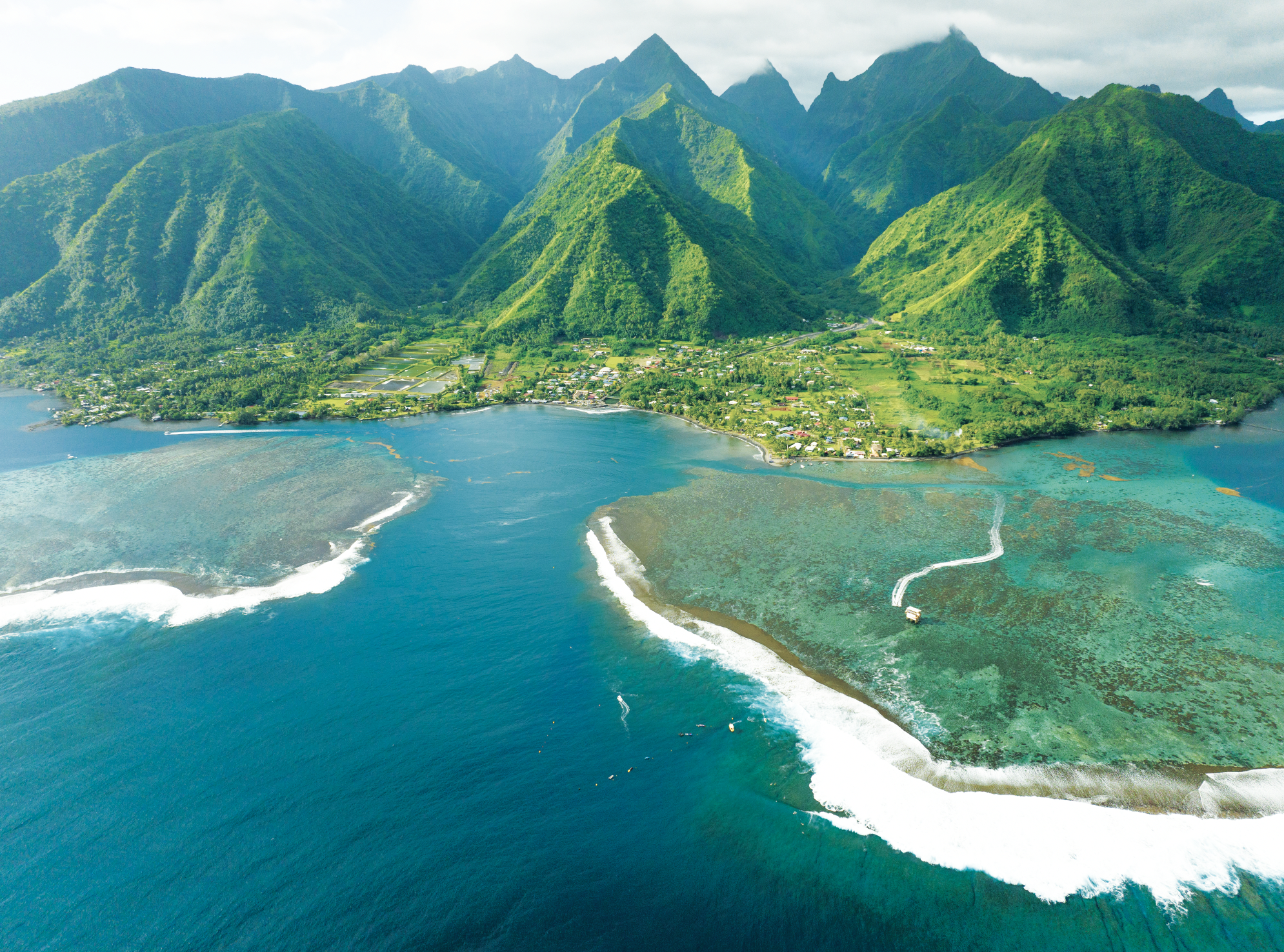
In keeping with the limit of two surfers per gender, per nation, the Australian flag will be flown by Ethan Ewing (No. 2 in the World Surf League rankings at the time of writing) and the aforementioned Robinson (No. 5) in the men’s category, and Tyler Wright (No. 3) and Molly Picklum (No. 5) in the women’s. On this form, hopes of a homegrown medal haul are high.
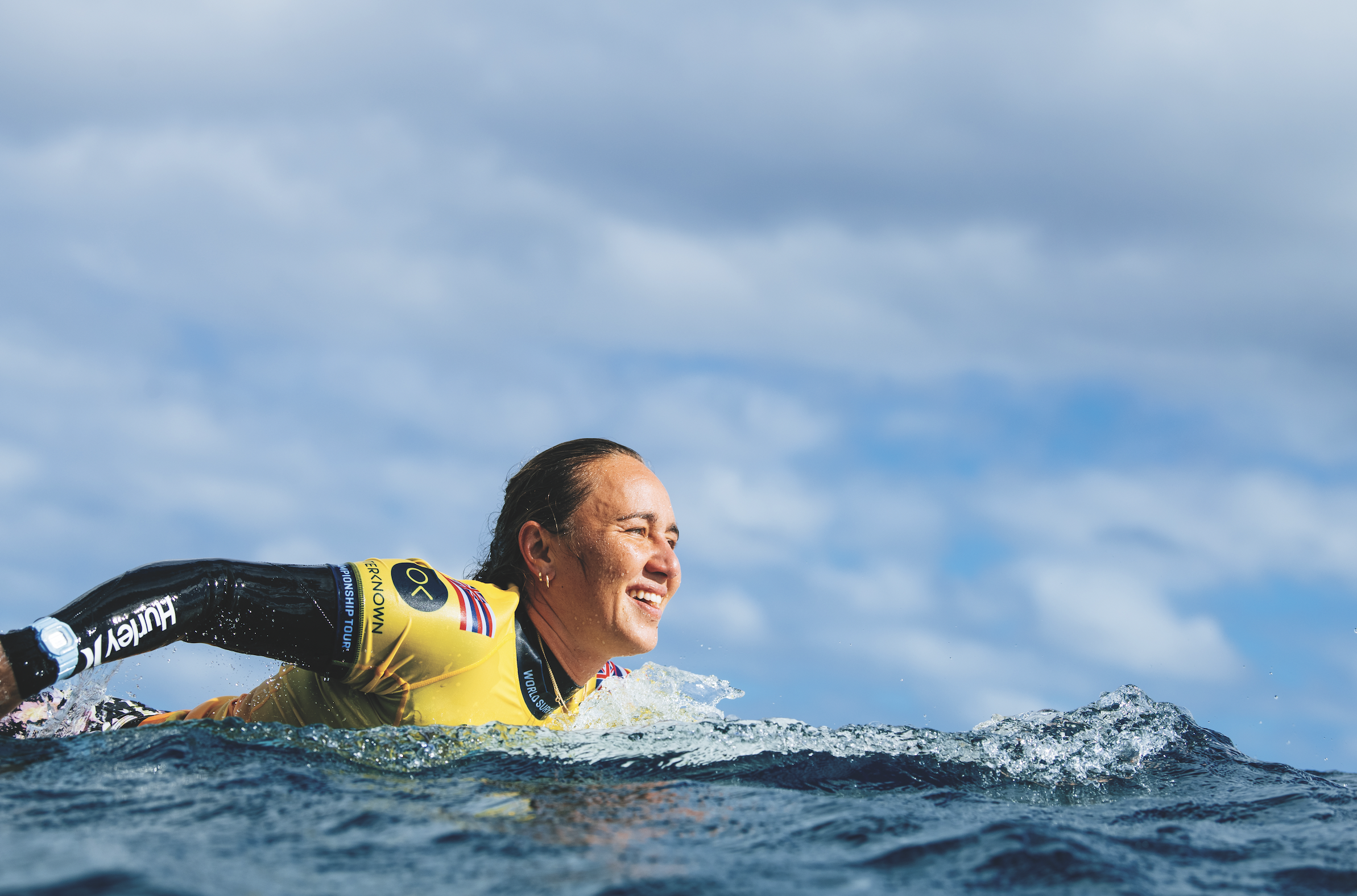
Olympic officials could have chosen a site off the coast of France, such as the surf towns of Biarritz or Hossegor, but historically, Mother Nature brings more sizable waves to Tahiti at this time of year. Plus, surfing has deep cultural ties to the region. The sport originated in Polynesia and dates as far back as the 12th century; it was practiced by Polynesian royalty. Teahupo’o is also a world-class wave that challenges the mental and physical prowess of even the most experienced competitors. The high risk of surfing this spot guarantees thrills that officials anticipate will boost viewership.
Located in the gin-clear waters of the South Pacific with a background of mountains that appear to be draped in jade-green crushed velvet, Teahupo’o (pronounced TAY-a-hoo-poh-oh) is one of the sport’s most infamous swells. (Its name loosely—and cheerily—translates to “place of skulls”.) According to Memoirs of Marau Taaroa, Last Queen of Tahiti, printed in 1893, the first person to surf it was actually a woman from the island of Raiatea, in the 19th century. Not until the 1980s did anyone dare attempt it again, with the first competition hosted in the late 1990s. Former pro turned filmmaker Chris Malloy has called it “the wave that has changed surfing forever”.
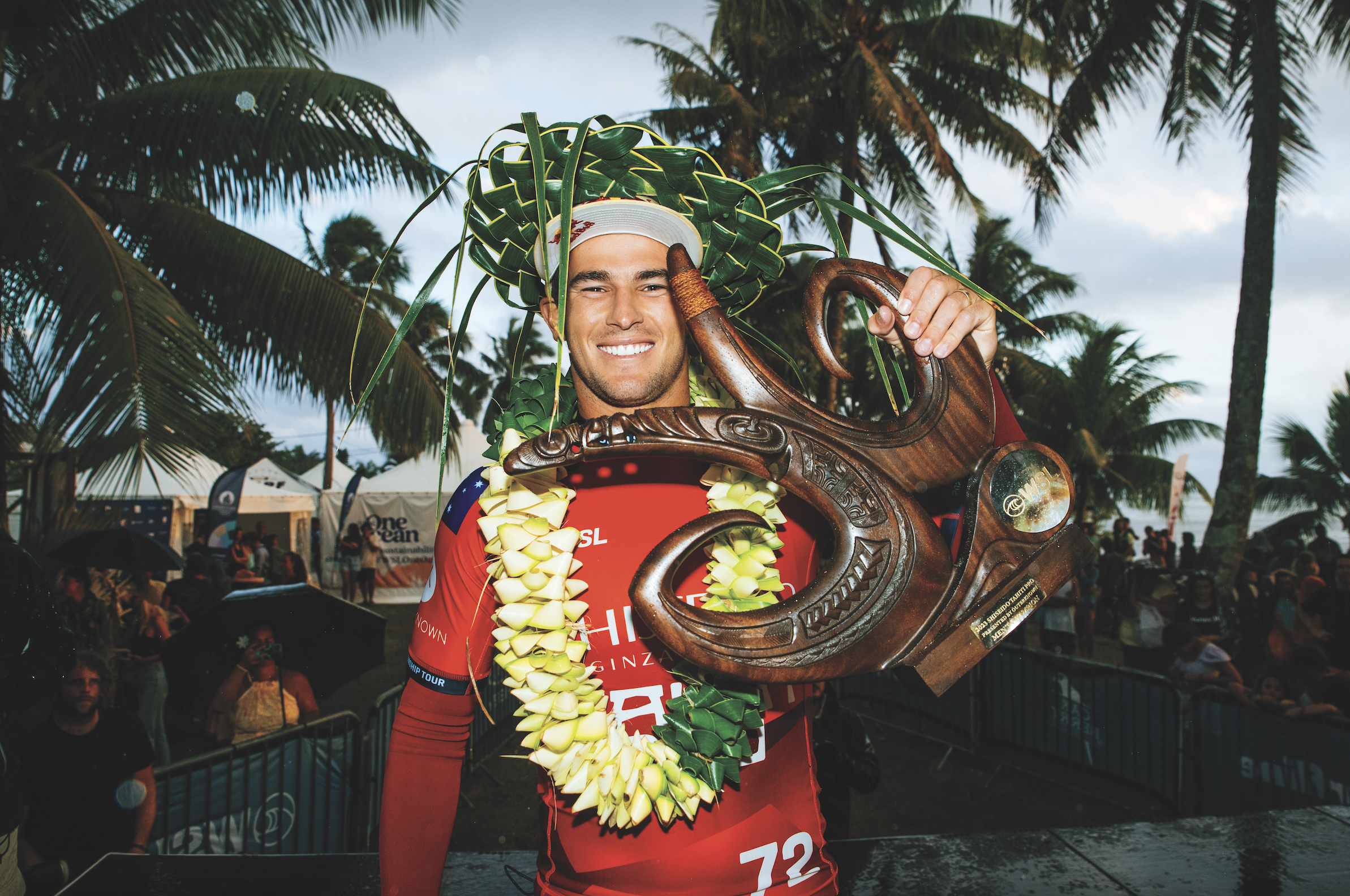
In the right conditions, Teahupo’o can tower upwards of six metres. That may sound small compared to the monster-size Jaws in Maui or Nazaré in Portugal—which can climb as high as 25 metres—but it’s not the height that makes Chopes, as the wave is lovingly called, so special. It’s the weight. When surfers describe a wave as heavy, they’re referring to its combination of a thick lip (the powerful section that starts to curl over) and the amount of water surging behind it.
Like most of the surf breaks found throughout French Polynesia, Teahupo’o is a reef break, meaning the water spills over the surface of knife- sharp coral. Chopes is unique because around 50 metres beyond the reef, the ocean drops more than 15 metres. As swells come toward the shore, the transition from deep water causes them to jack up over the coral before quickly crashing down with tremendous force.
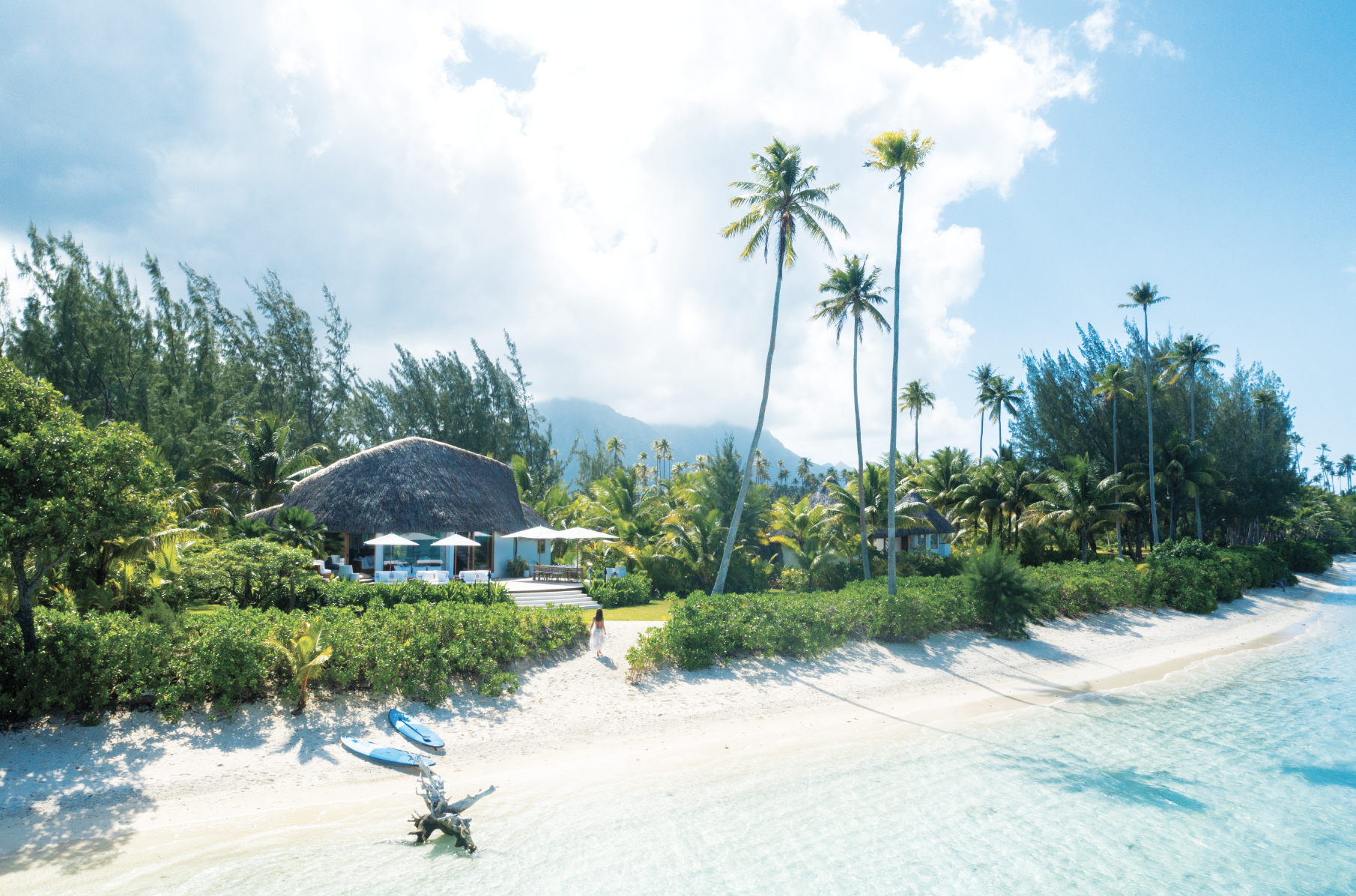
“The reef evolved perfectly in order to absorb the wave’s energy in the shortest distance possible to create this natural wonder,” surf superstar Laird Hamilton tells Robb Report. “It’s a wave that stands straight up and creates a huge barrel. It’s one of the greatest waves on Earth.” In 2000, Hamilton rewrote surfing history when he rode what has been dubbed the Millennium Wave here. Up until then, Teahupo’o was considered too perilous to attempt when it reached a certain size. Hamilton, a pioneer of tow surfing, had a jetski pull him into what is still considered one of the heaviest waves ever ridden. Surfer magazine published a memorable cover of him getting barrelled with just the words “Oh my god…” because the feat was so dangerous.
In places, the reef lurks just 50 centimetres beneath the water’s surface, and the lip can act like a liquid guillotine if it clamps down before a surfer exits the hollow tube of the wave, known as the barrel. Had Hamilton wiped out, he wouldn’t have had an escape route.
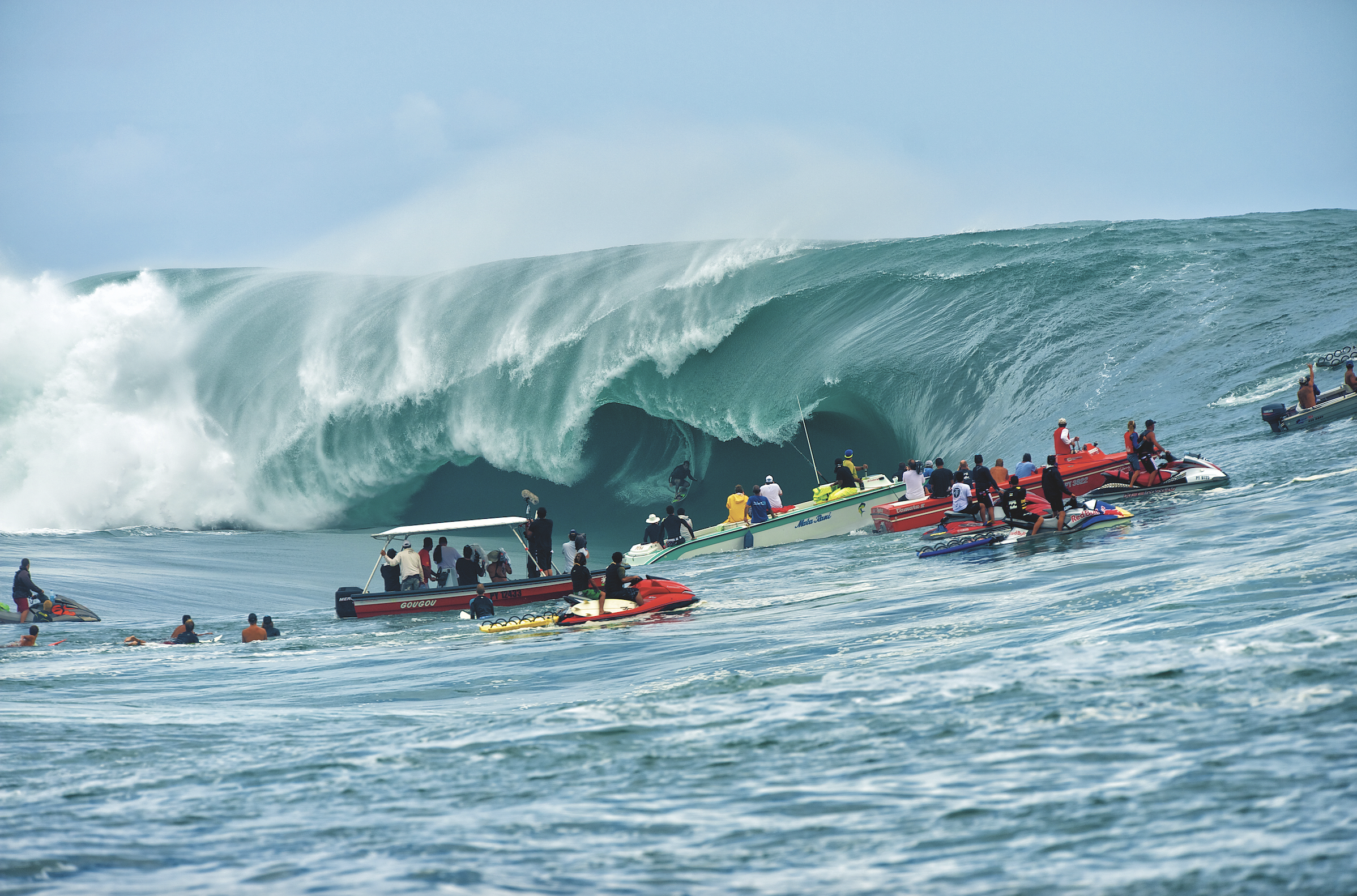
I’m an avid amateur surfer and live on Maui part-time to take advantage of Hawaii’s waves, but even on a gentle day, I wouldn’t attempt Teahupo’o. Teahupo’o village has a water-safety patrol that watches over athletes during contests. Still, a handful of surfers have lost their lives here, and many go home with serious battle wounds. In August last year, during a practice session for the Tahiti Pro, Ethan Ewing fractured two vertebrae in his back after crashing out in solid, but average, six-foot waves—an accident that arguably cost him top spot in the world rankings.
In classic gung-ho-surfer fashion, though, the Queenslander was back in the water at Teahupo’o three months later, one eye still resolutely fixed on Olympic glory. “Definitely more anxious than excited heading back to Tahiti after hitting the reef really hard last time,” he posted on his Instagram account. “Teahupo’o is still seriously intimidating, but I feel like I’ve made some steps in the right direction.”
Unless you surf, Tahiti Iti probably isn’t on your radar. Starting from the largest town of Taravao, the south-coast road ends at the village of Teahupo’o, hence its nickname, the End of the Road. The community, just 500 metres from the wave, is the antithesis of the glitz and glamour of Paris or even nearby Bora Bora. This is a slice of tropical paradise that has somehow evaded development. To reach the contest each day, I park at the end of the road, then walk over a one-lane bridge and follow a sandy path that passes local homes.
“All of your senses are heightened here,” former world surf champion C. J. Hobgood tells me when I run into him at the event. “It’s not just the wave—it’s the island. Everything looks five- dimensional. Mountains seem stacked on mountains and glow a vivid green. You turn to the right and these bluer-than-blue waves are breaking. Then a rainbow might appear in the sky. The raw beauty is overwhelming to take in when you first arrive.”
Surfers talk of feeling the mana, a Polynesian word for spiritual energy, here. Jack Robinson even referenced it after his victory in the Tahiti Pro. It may sound woo-woo, but I undoubtedly feel something when I arrive after a 90-minute drive south-west from the hotel-lined harbour of Tahiti Nui, the island’s larger, more developed area. Tahiti Iti’s empty beaches and waterfall-riddled lush interiors remind me of a quieter, more vibrant version of Hana, a little corner of Maui with just one hotel, a handful of restaurants and kilometres of untamed nature. In an era of over-tourism, this kind of purity comes with a trade-off: You won’t find five-star hotels or celebrity-chef restaurants on Tahiti Iti. In fact, it doesn’t have any hotels at all—and won’t be opening any ahead of the Games.
Locals have been adamant that Olympic infrastructure remains minimal. The proposed construction of a three-storey judging tower directly on the reef at Teahupo’o has been a major concern among residents and environmental groups. The one Olympic improvement locals welcome is a new bridge that will connect to the beach in front of Chopes.
I check into Villa Mitirapa, newly built in the rural community of Afaahiti, a 25-minute drive from Teahupo’o. Giant carved wooden doors lead to an open-air living room, a plunge pool and views of the lagoon, and every evening a chef drops by with a delicious preparation of the catch of the day. In the village of Teahupo’o, you’ll find family-owned guesthouses such as Vanira Lodge, a collection of three bungalows tucked up in Te Pari (“the cliffs” in Tahitian), as well as A Hi’o To Mou’a, a B&B run by the proprietor of hiking outfit Heeuri Explorer.

Pro surfers are typically hosted by the same local families year after year. (During the Olympics, athletes will be housed on a ship anchored in a sandy area offshore to avoid damaging the seabed.) Hobgood tells me he made visits to his “adopted Tahitian family” for nearly two decades. For the past five years, he has come to Teahupo’o to help coach reigning Olympic champ, Hawaiian Carissa Moore and now stays with her adopted family. “They take us on hikes you’d otherwise never know how to access and have rich stories about the place,” he says. “And everything they prepare for us at meals, from the passion-fruit jam to the chilli sauce, is homemade.”
The next big thing being “adopted” by a Tahitian family is hiring Raimana van Bastolaer as your guide. For a first-time visitor, Tahiti Iti can be far harder to access than other islands, which is perhaps why so few people explore the peninsula. You need a local to reveal where to go, and van Bastolaer makes you feel like an insider.
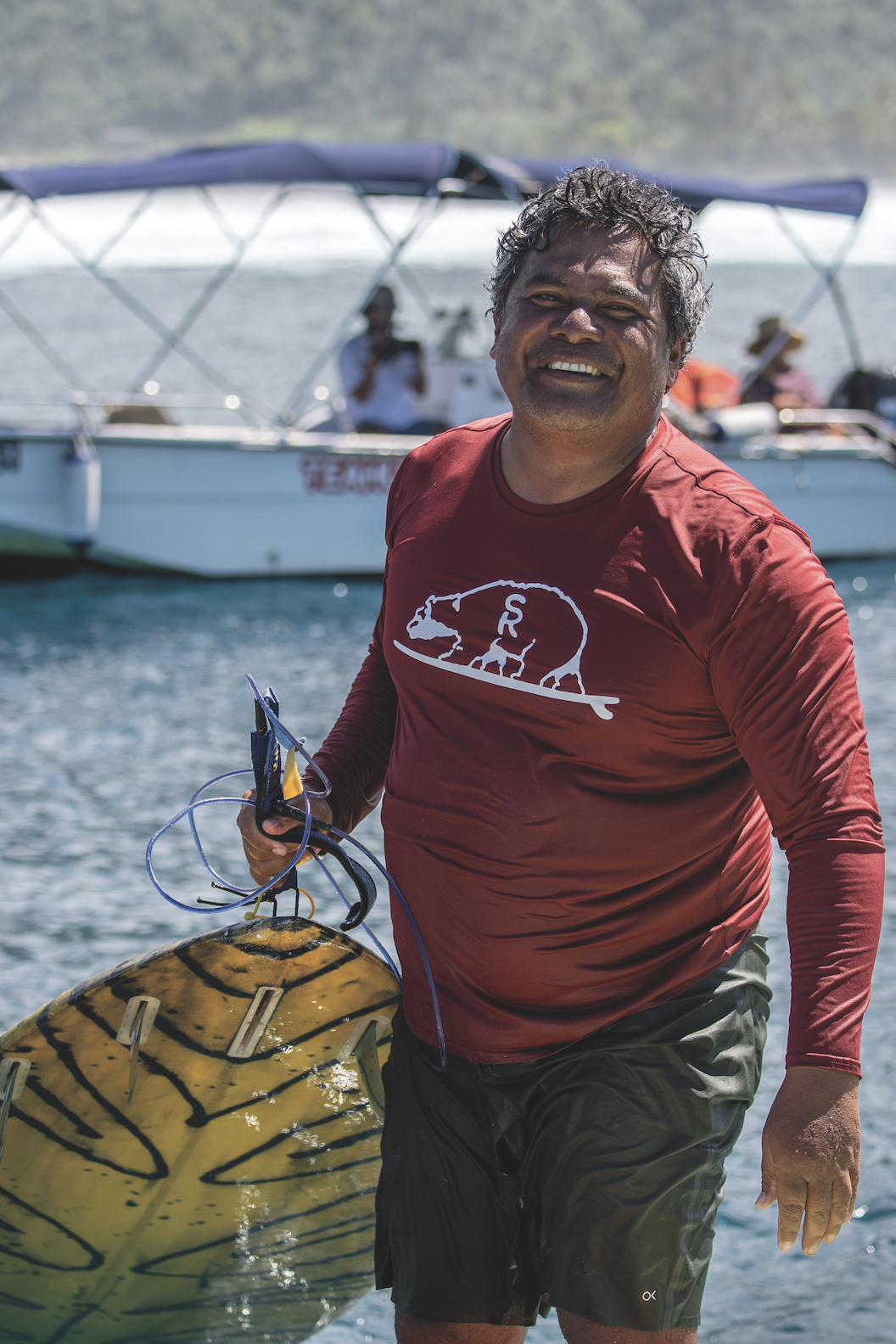
Born and raised in the capital of Papeete, he was one of the first locals to surf Chopes, and over the years, his intricate knowledge of the wave has earned him the nickname the Godfather of Teahupo’o. He was out in the channel with Hamilton the day the American had his historic ride, and John John Florence and Kelly Slater are among the surfers who stay with him when they’re in town. Van Bastolaer even did a stint as a part-time coach at Surf Ranch, Slater’s central California wave park. Thanks to his non-stop pursuit of a good time, everyone wants to be around him. Now 48, the stockily built, dauntingly athletic van Bastolaer has become the go-to guide for visitors ranging from Julia Roberts, Margot Robbie and Jason Momoa to Mark Zuckerberg and Prince Harry. “I get to yell at princes and CEOs,” he jokes. “I’m out in the water with them telling them when to pop up and paddle. And they love it.”
Tahiti’s unofficial ambassador lives and breathes surfing. Through his company, Raimana World, he takes just one or two guests at a time on private curated surf tours throughout French Polynesia’s two central archipelagoes: the Society Islands (which are home to Tahiti) and the Tuamotus; he plans to add Fiji soon. Some of his clients base themselves on their own yachts or charter one through Pelorus. The yacht specialist’s Tahiti portfolio includes the 77-metre La Datcha, which has two helipads, a submersible and a spa.

Other clients he directs to exclusive properties, such as Motu Nao Nao, a new 25-hectare private-island resort in the cerulean lagoon of Raiatea with just three enormous villas crafted from coral, wood, and shells. A roving bar bike delivers custom cocktails to guests as they explore the island, and the French chef, inspired by Asian and North African cuisine, prides himself on never repeating a dish, no matter how long guests stay.
Van Bastolaer gets only one or two clients a year experienced enough to be coached into a barrel at Teahupo’o. “Most just want to get close to the wave to feel its energy and hear it roar,” he says. “That’s enough to give you an adrenaline rush.” Locals are incredibly protective of their surf spots, and van Bastolaer stays away from popular breaks. “Out of respect, I don’t take clients out if there are more than a few people in the water. Luckily, I have access to toys that get us away from the crowds.” He island-hops by helicopter, yacht or jet boat, then transports guests to surf breaks via high-speed RIB (rigid inflatable boat) or jetski. Most days average two to three hours of surfing, and he sprinkles in other activities such as snorkeling, whale watching (July to November) and barbecues at his house.
Papara, the beautiful black-sand beach where van Bastolaer honed his skills, 45 minutes from Teahupo’o, will be turned into a fan viewing zone with jumbo screens during the Olympics. Papara is one of the most forgiving surf breaks in Tahiti, and I head here to longboard. La Plage de Maui, a simple restaurant with sandy floors, plastic chairs and lagoon vistas, becomes my daily après-surf spot. Located in West Taiarapu, 40 minutes east of Papara, with nothing but coastal road and local homes in between, this humble spot sits next to Maui Beach, one of the only white-sand beaches on the whole island. This stretch may be Tahiti Iti’s best-kept secret.
After a barefoot walk along the shore, I don’t bother to put my shoes back on before heading into the restaurant, where servers proudly sport Tahiti Pro T-shirts and posters of pros hang on the walls. At a waterfront table, I spot rainbow-hued parrotfish and Moorish idol in the glassy lagoon. I’m pretty sure I could live on a diet of local Hinano beer and poisson cru, Tahiti’s national dish of raw fish marinated in lime juice and coconut milk. My final day, I ask my waitress if she’s concerned the Olympics might overexpose this laid-back, oft-forgotten enclave. She just laughs in reply.
On the drive back to my villa, I remember what van Bastolaer told me when we were introduced a year ago: Tahiti Iti’s specialness is lost on those seeking overwater bungalows or nightlife. It’s a place you can’t know in a day. The island reveals itself to you slowly. And even when van Bastolaer is your host, he won’t give away all its secrets.
You may also like.
13/04/2024
The Boldest, Most Exciting New Timepieces From Watches & Wonders 2024
Here are the highlights from the world’s biggest watch releases of the year.
Watches & Wonders, the world’s largest watch show, is in full swing in Geneva. The highly anticipated cascade of new releases is marked by confident individual brand identities — perhaps a sign that watchmakers are done scrambling through the violent collision of restricted supply and soaring demand for high end watches. All seem to be back on solid footing.
Steady confidence is a good thing. Consider Jaeger-LeCoultre offering up traditionally styled grand complications or Vacheron Constantin revamping the classic Patrimony with smaller cases and vintage-inspired radially brushed dials. Consider TAG Heuer celebrating the 55th anniversary of the square Monaco with a skeletonized flyback confidently priced at US$183,000, or Moser similarly showing off a fascinating skeletonized tourbillon in its distinctive 40 mm Streamliner at US$86,900. IWC has leaned hard into their traditionally styled Portugieser line, including an astounding Eternal Calendar complication. We find the storied French houses of Cartier, Chanel and Hermes blurring the lines between jewelry and watchmaking with the technical prowess and artistic whimsy that originally earned these brands their exalted place in the hearts and minds of sophisticated aesthetes. Confidence abounds in 2024.
We could go on and on with examples, but the watches below will demonstrate that for 2024 the big watch brands dared to be themselves, which appears to have given them the confidence to take some seriously compelling horological risks. We have separate coverage of off-show releases and, of course, Patek and Rolex, so keep and eye out for those.
—
A. Lange Söhne Datograph Perpetual Tourbillon Honeygold Lumen
Chanel Bobbin Cuff
You may also like.
A Gucci Garden Blooms in Sydney
On a rainy Sydney night, the drinks talent from Maybe Sammy mixed with guest bartenders from Giardino 25 in Florence, for a night of liquid magic.
Since hanging out its shingle in 2022, Giardino 25, the all-day café and bar located in Gucci’s palatial, multidisciplinary space in Florence, has been a boon to stylish tipplers. Taking inspiration from one of its previous tenants (a longstanding florist), the garden-themed joint (Giardino is the Italian word for garden) serves delicious aperitivi and dangerously addictive cocktails.
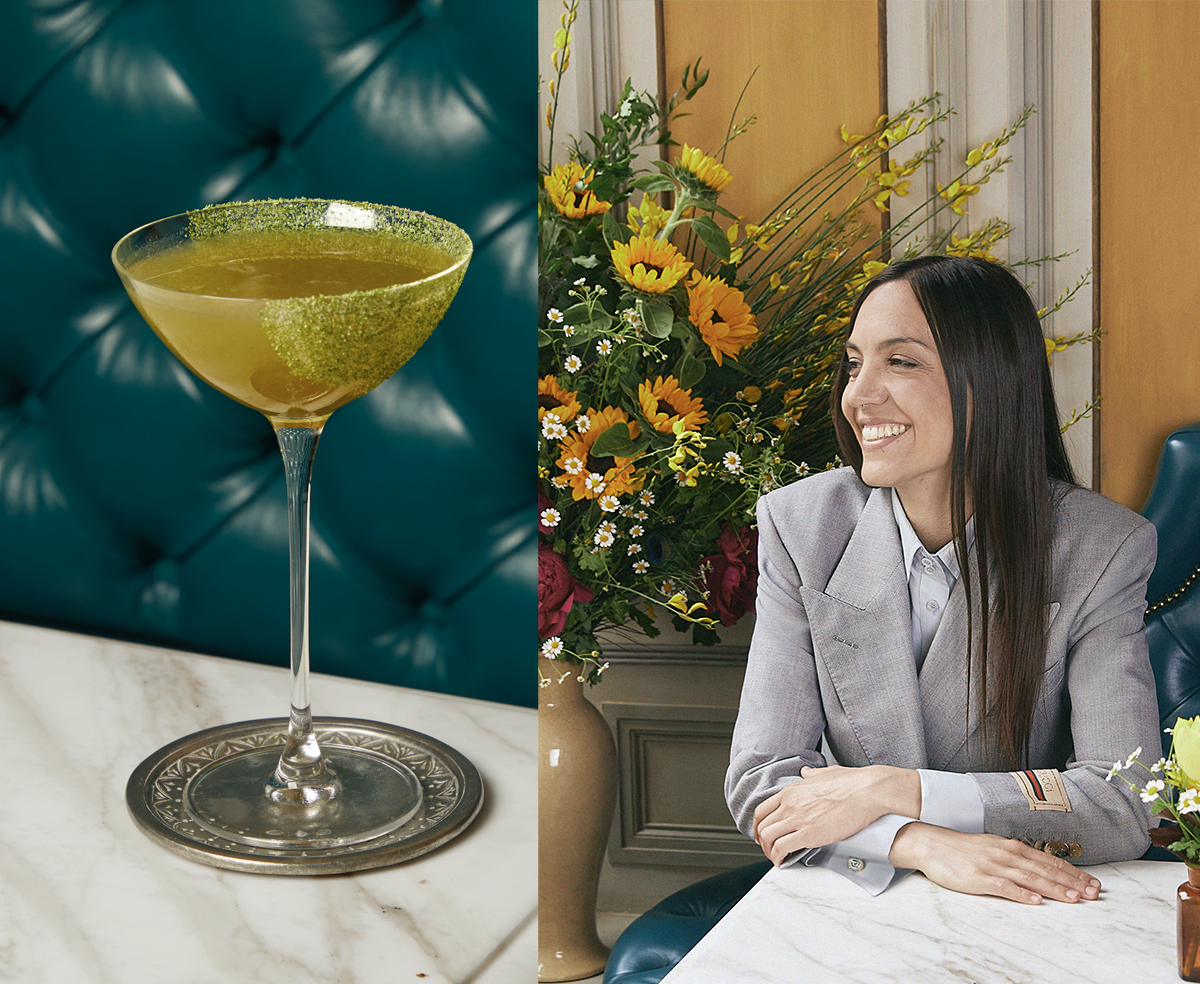
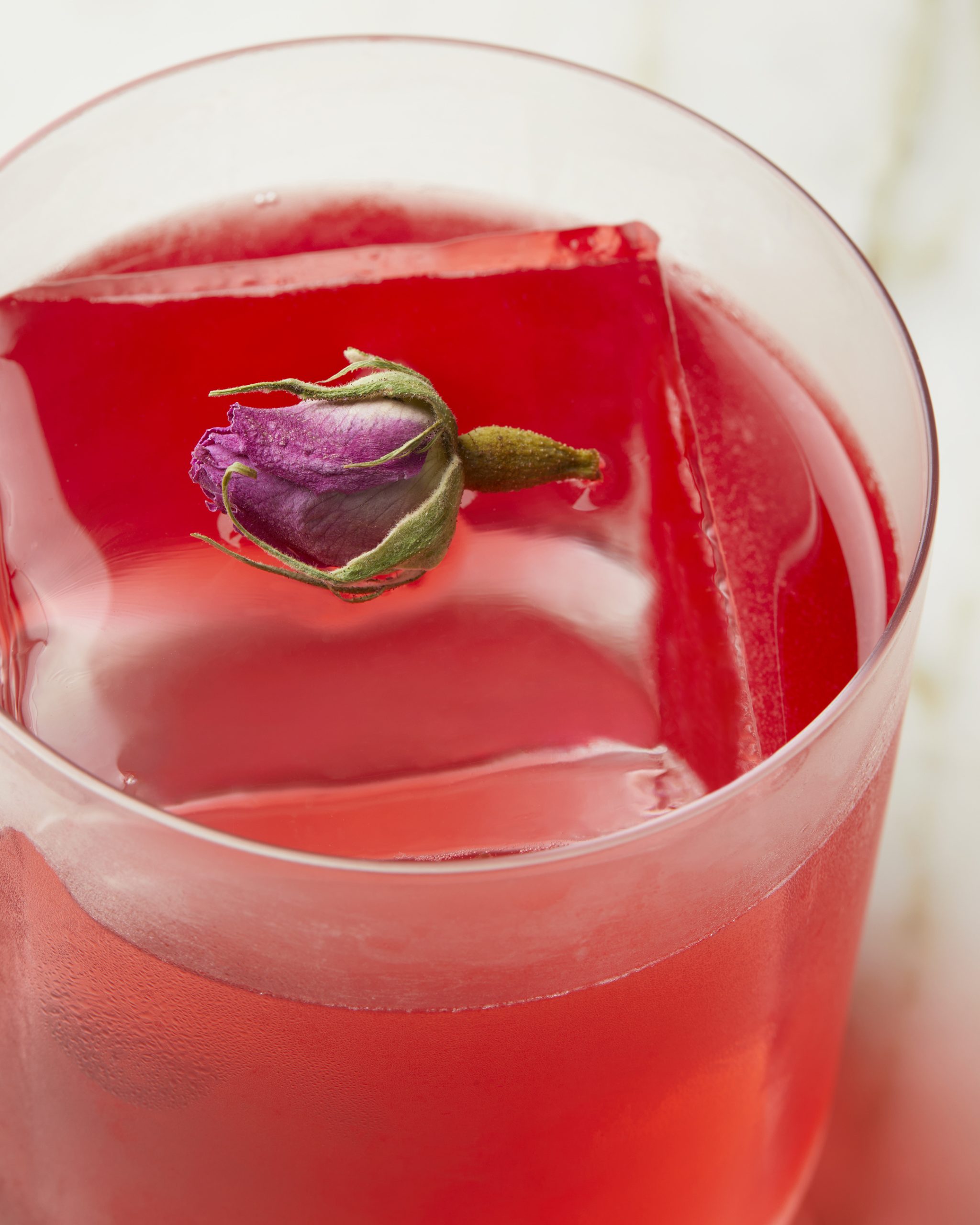
Giardino 25 took bloom this past Tuesday at a pop-up at El Primo Sanchez in Paddington. The Maybe Cocktail Festival in Sydney is a series of 20 events scattered throughout the city curated by the award-winning Sammy’s Cocktails team. The festival aims to spur knowledge-sharing and foster excellence in Australia’s drinks scene.
“Last year we held 16 events and they were all packed,” says Stefano Catino, director of hospitality at Public, the management company behind Maybe Sammy venues and bottled drinks, “so this year we’ve curated extra events and flown out even more international bars and bartenders.”
“Nineteen of the 21 events are free to attend, which is very important to us,” he continues. “The cost of living is high, and it’s very expensive for Australians to travel overseas, so this festival allows people to drink cocktails from an amazing bar in Rome or try a Tommy’s Margarita from the gentleman who created it without the cost of a plane ticket.”
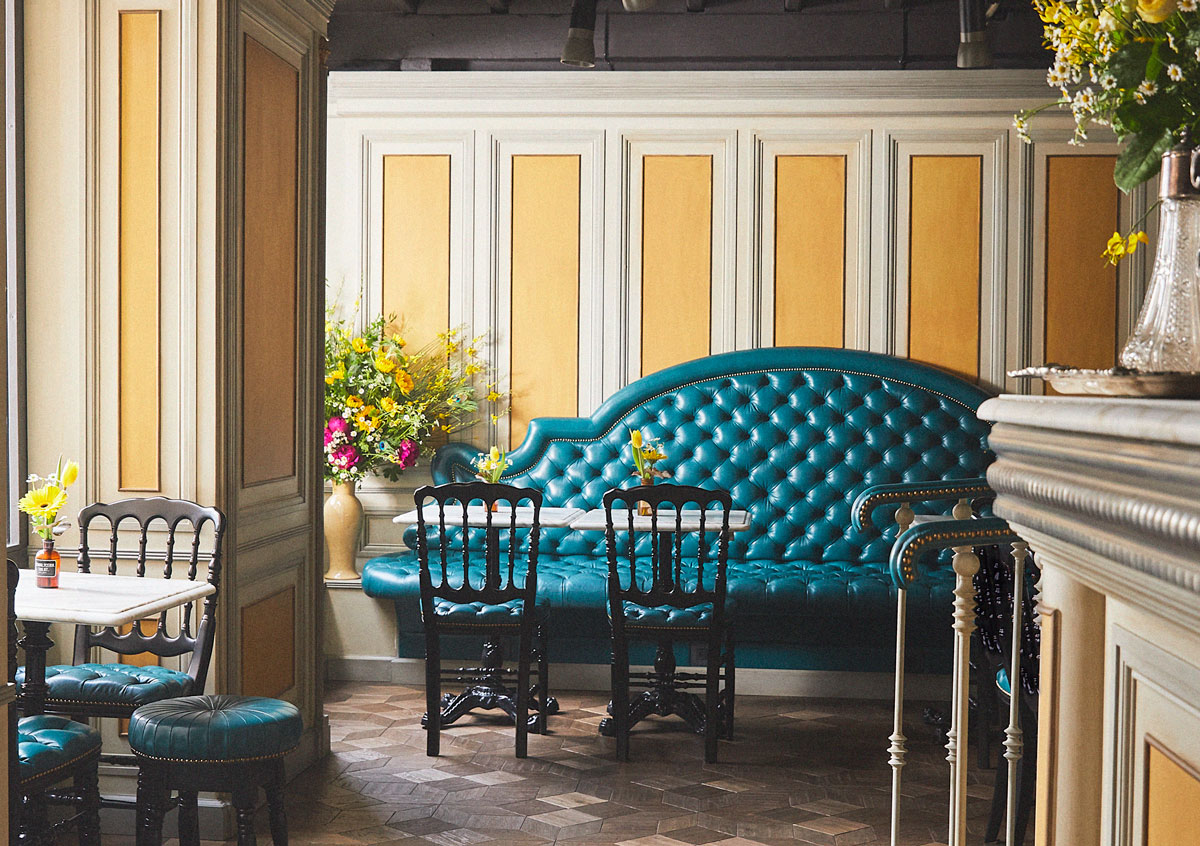
Dressed head to toe in Gucci, and using the bar as her personal catwalk, Giardino 25’s special guest, Martina Bonci, looked every bit the star behind the bar. “We have brought our mix of classic Italian influences and innovation,” she told Robb Report, “so guests in Australia get a little slice of what we do in Florence.”
Among her tantalising pours were powerful dirty martinis decorated with shimmering gold leaf and Aurora, a transparent twist on the Negroni.
Reflecting on her whirlwind trip down under, Bonci said their visit to Bondi Beach and the cocktails at Maybe Sammy were the highlights.
“The bartenders at Maybe Sammy are world-class,” she explained. “There is a good reason they win awards and have a respected reputation overseas. And El Primo Sanchez has such a fun atmosphere—we had a great night.”
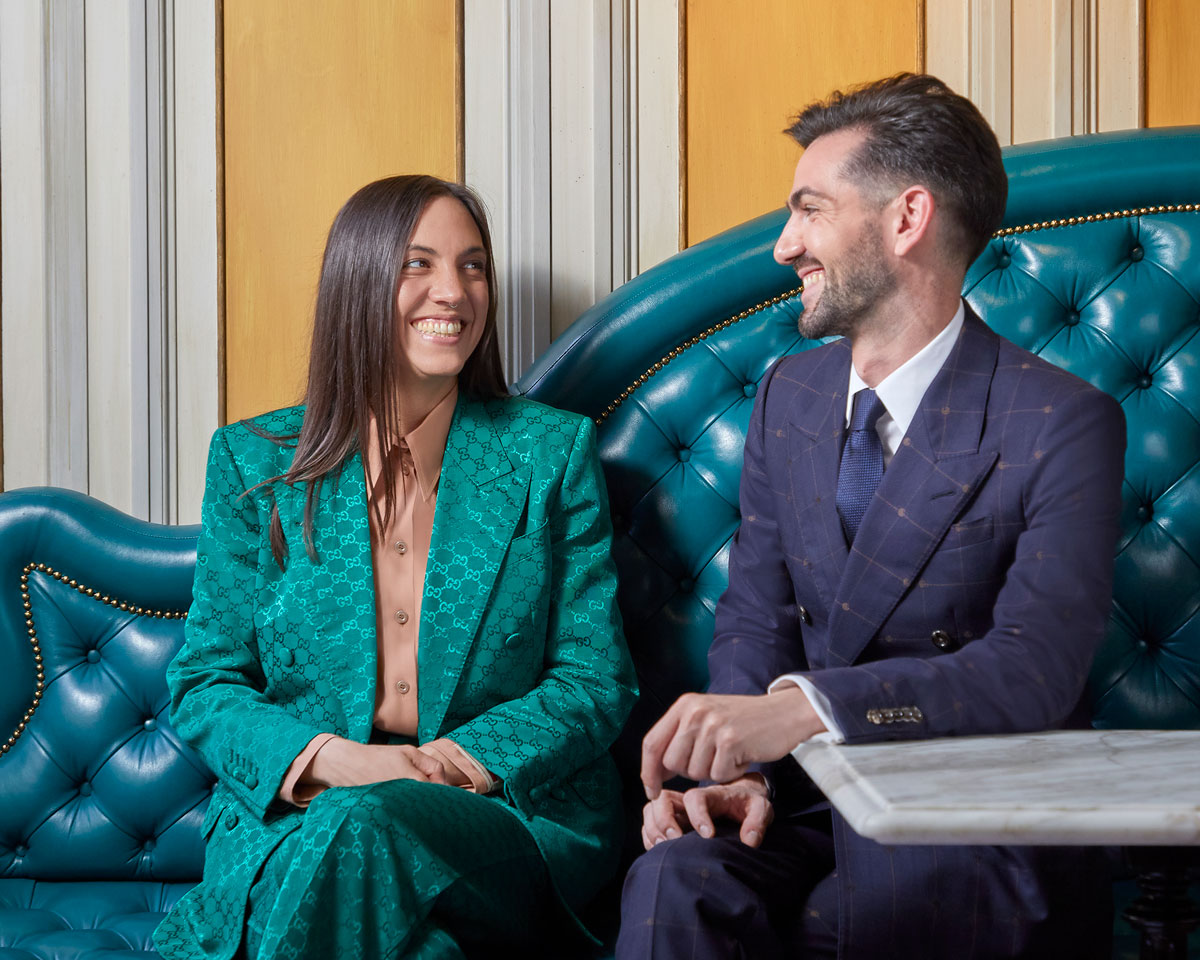
Bonci, who came to prominence in a long string at Milanese hipster joint Gesto and is known for her use of agave, favors drinks dripping with seasonal fruits and citrus flavors. Having tried her creations, we do, too.
She made a serious impression on Sydneysiders, who would do well to make a pilgrimage to see her in action on home turf. As if any of us need another reason to visit Italy.
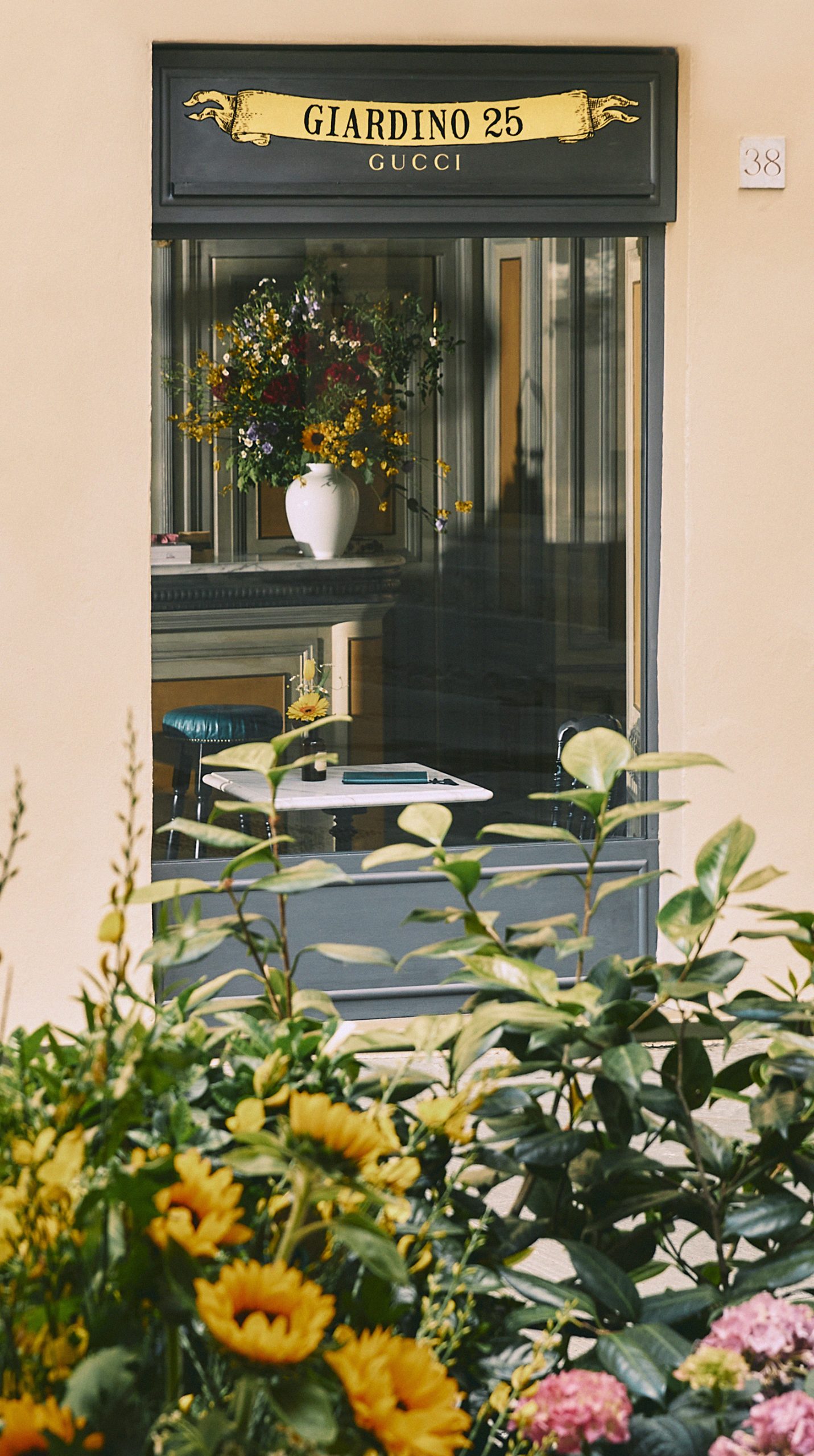
The Maybe Cocktail Festival, continues this weekend in Sydney, with the public welcome to attend a Bartenders Brunch at Sydney’s Alpha on Sunday from 11.00 am – 3.00 pm, hosted by George Calombaris.
View the program: Maybe Cocktail Festival @maybe_cocktail_fetsival
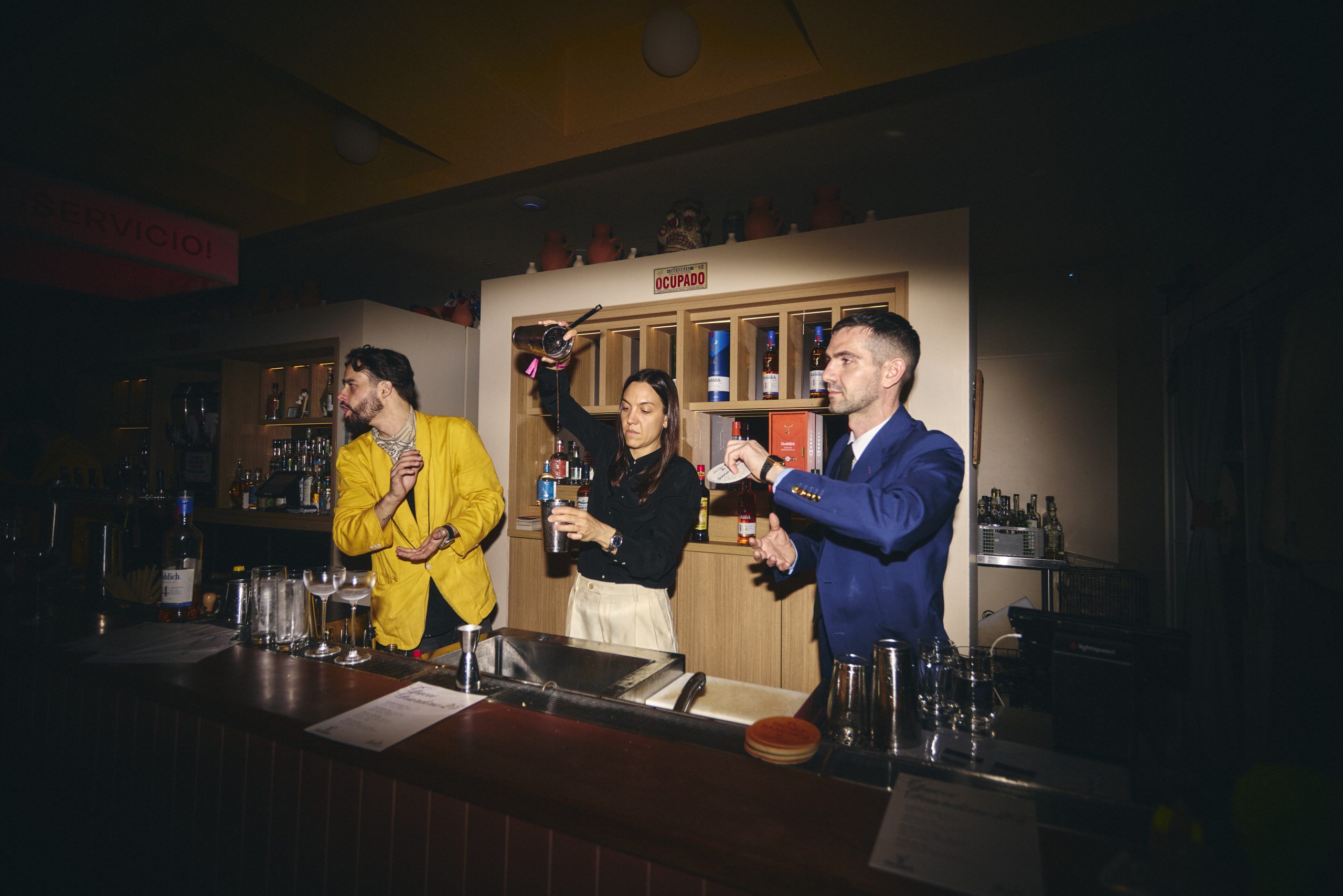
All images courtesy of Gucci.
You may also like.
Patek Philippe Brings Back Collector Favourites at Watches & Wonders 2024
Both the Nautilus Chronograph and Aquanaut Travel Time receive a welcome return.
If you’re a watch fan, there’s every reason to believe that a Patek Philippe Nautilus, Patek Philippe Aquanaut—or both—would be high on your wish list. Both collections are of historical significance, helping pave the way for the influence of the steel sports watch category—and subsequent chokehold on the market today.
So, when Patek Philippe unveiled its newest releases at Watches & Wonders in Geneva, it was a pleasant surprise to see the return of two of the best past iterations of the Nautilus and Aquanaut collections.
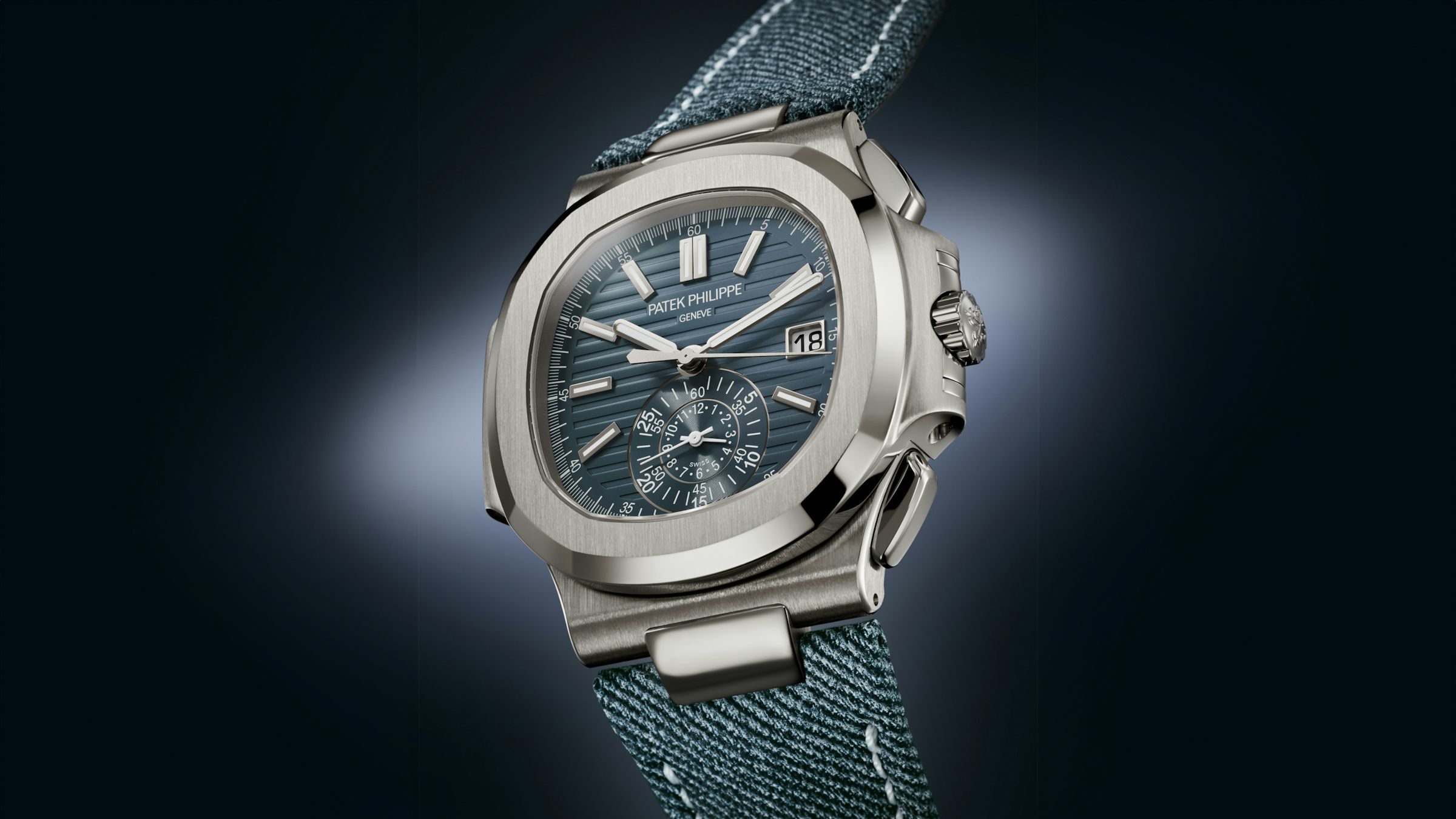
First, we get a new Nautilus Chronograph, with the return of the revered 5980, now replete with a new case in white gold and a denim-like strap (a contentious issue among watch pundits). Discontinuing all Nautilus 5980 models earlier this year, including the collector-favourite 5980/1AR in Rose Gold, left a sombre feeling among Nautilus fanatics. These celebrated chronographs, renowned for their distinctive porthole-inspired design and air of sporty elegance, are some of the most sought-after watches in the Patek Philippe catalogue. Thus, the revival of the 5980, now in white gold, is a cause for collectors’ celebration.
The new offering retains its chronograph function with mono-counter tracking 60-minute and 12-hour counter at 6 o’clock on the dial, but now comes on a new denim-inspired, hand-stitched fabric strap with a Nautilus fold-over clasp in white gold—some will love it, some won’t.
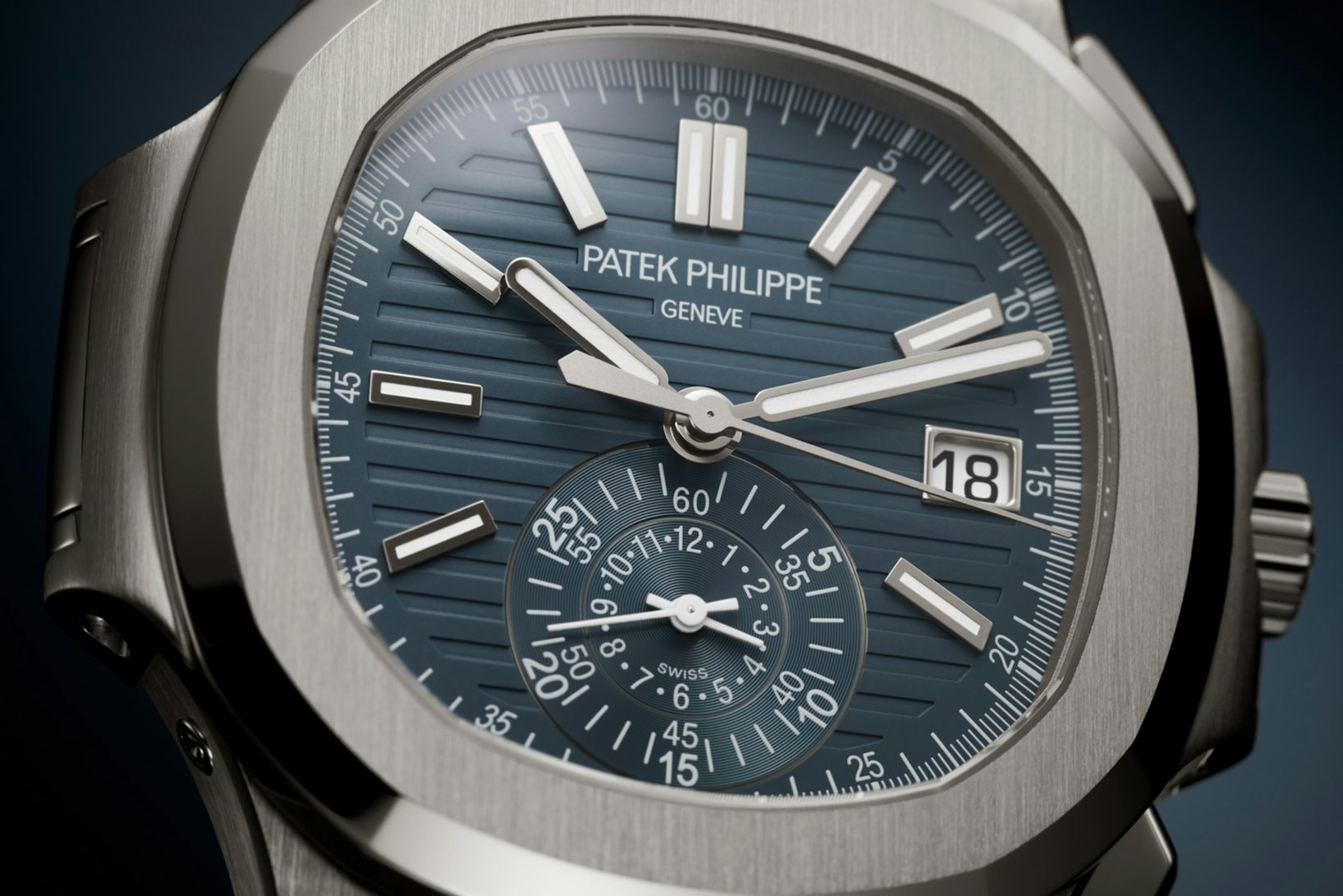
The Calibre CH 28‑520 C/522 powers this new Nautilus with its flyback chronograph, all of which is visible through the transparent sapphire crystal caseback. The dial is also incredibly eye-catching, with a beautiful opaline blue-gray hue accentuated by white gold-applied hour markers with a white luminescent coating. It is priced at approximately $112,000.
Also returning to the fold is the Patek Philippe Aquanaut Travel Time, now with its own bluish hue dial—similar to its Nautilus counterpart. After discontinuing the Aquanaut Travel Time 5164A this year, as well—a watch often regarded as the greatest Aquanaut to date—Patek Philippe surprised all with the new 5164G in white gold. Its greatest attribution is the clever Travel Time GMT function, which clearly rivals the Rolex GMT-Master II as perhaps the travel-friendly watch of choice (if acquiring one was that simple, of course).
For those who prefer the Aquanaut’s sportiness and easy-wearing rubber strap, this newest iteration, with its Opaline Blue-gray dial and matching rubber strap with a deployant clasp, is undoubtedly an icon in the making. The new 5164G has a 40mm case and features the Calibre 26‑330 S C FUS movement, which can also be viewed via the transparent sapphire crystal caseback.
Expect to pick up the new Aquanaut Travel Time for around $95,250.

—
Follow @robbreportau for all your Watches & Wonders coverage, and more!
You may also like.
13/04/2024
Rolex Kicks Off Watches & Wonders 2024 with a New GMT-Master II
The new stainless steel GMT-Master II has already been dubbed the “Bruce Wayne”.
It may not be the GMT that watch pundits were speculating on—or that collectors were hoping for—but the new Rolex GMT-Master II with a new grey and black ceramic bezel adds dazzle to the revered Rolex collection, which this year celebrates its 70th anniversary.
The idea of a new Rolex GMT launching at the world’s biggest watch fair is cause for a little madness. While the watch community eagerly awaited what was thought to be the discontinuation of the highly sought-after GMT “Pepsi” and the return of the GMT “Coke,” the luxury Swiss watchmaker had other plans.
Instead, we’re presented with a piece that, on paper, hasn’t changed much from previous GMT releases. That’s not to say that this isn’t an impressive release that will speak to consumers—the new GMT-Master II ref.126710GRNR, dubbed the “Bruce Wayne,” is definitely a sight for sore eyes.
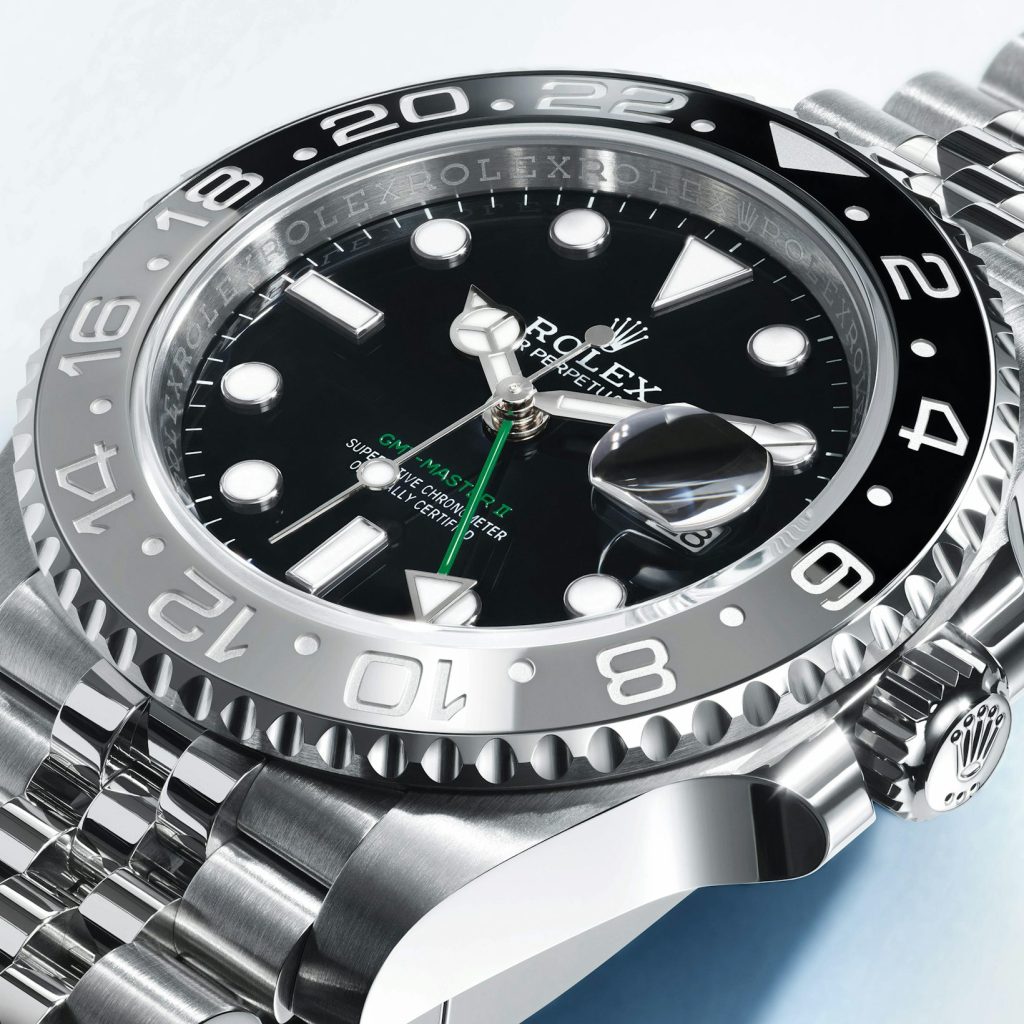
This new GMT retains the same dimensions and movement as the other watches in the GMT collection, along with its 40mm size case and the option to fit either an Oyster or Jubilee bracelet. The obvious changes, albeit subtle, come in the way of its mostly monochrome return; a fact that will appease traditionalists. If you’re opposed to the attention-drawing “Pepsi”, “Sprite”, or “Batman” iterations, this model is a stealthier pick—much like pseudonymous Bruce Wayne.
The other noticeable change is the “GMT-Master II” now applied in green text and a 24-hour hand in green; perhaps a nod to the 2007 Basel World GMT release.
Like many Rolex timepieces, this will generate great hype and attention, so don’t expect allocations to come easily.
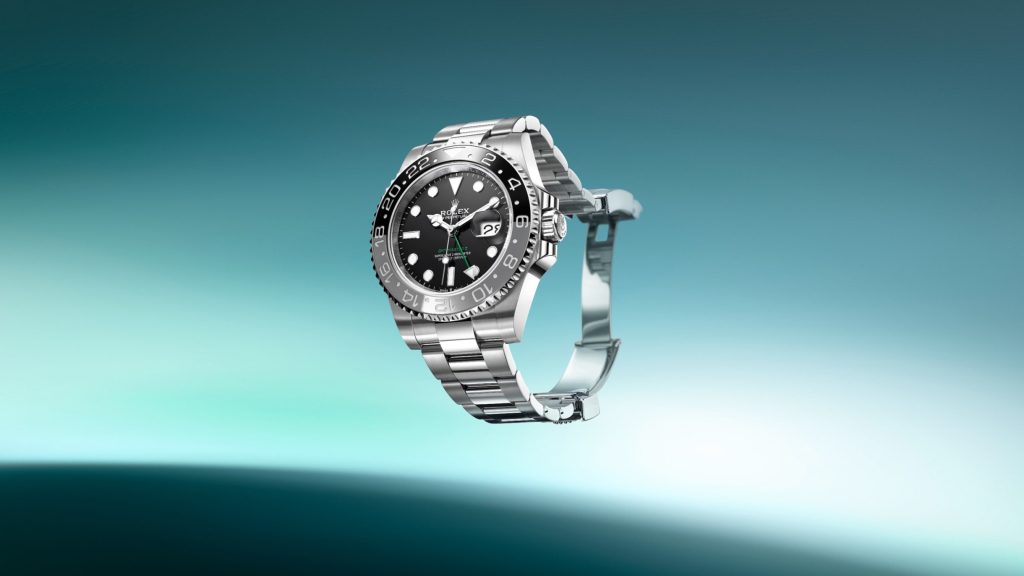
Model: GMT-Master II
Reference Number: 126710GRNR
Diameter: 40mm
Case Material: Stainless steel
Dial Colour: Black
Lume: Chromalight on hands and hour markers
Water Resistance: 100m
Bracelet: Oyster or Jubilee
Movement: Caliber 3285
Functions: Hours, minutes, seconds, date, GMT
Power Reserve: 70 hours
Winding: Automatic
Price: $17,150 (Oyster); $17,500 (Jubilee)
Availability: Now. Non-limited edition
You may also like.
13/04/2024






